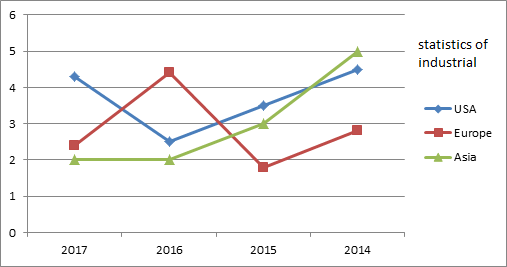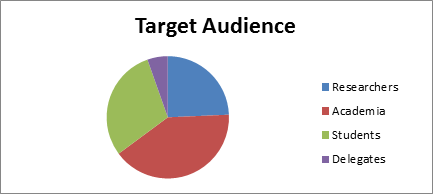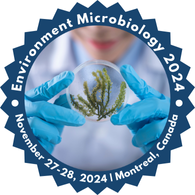About Conference
Conference Series LLC LTD takes immense pleasure & feels honored in inviting the contributors across the globe to attend 9th International Conference on Environmental Microbiology, Soil Microbiology & Microbial Biogeochemistry to be held during November 27-28,2024 at Montreal, Canada on the theme "Exploration of the latest applications in the field of Environmental Microbiology" which includes prompt keynote presentations, Oral talks, Poster presentations and Exhibitions.
Conference Series LLC LTD welcomes all the Microbiologist, Scientists, Research Scholars, Industrial professionals, Technologist and Student Delegates from Microbiology and Healthcare sectors to be a part of the esteemed Environmental Microbiology-2024. As this will be the best amalgamation of Academia and Research involving every aspect of Environmental Microbiology. It is open to all types of Research methodologies both from Academia and Industry.
Sessions/Tracks
Track 1- Aero Microbiology
Aero-Microbiology is the study of living animate microbes that are quiescent in the air. These microbes are attributed to as bio-aerosols .There are significantly earth atmospheric microorganisms than in oceans and soils; there is still a large bounteous number that they can affect the atmosphere . Once attributed in the air column, these microbes have the scope to travel long distances with the help of air and precipitation, increasing the occurrence of widespread disease by these microbes. These aerosols are ecologically suggestive because they can be identify with disease in humans, animals and plants. Typically microbes will be dependent in clouds. They are able to execute processes that alter the chemical composition of the cloud, and may even induce condensation.
Track 2 - Forest Microbiology
This Forest micorbiology is on sympathetic the activities of living organisms in the forest, like trees and mushrooms, from the organic and inorganic biochemical point of view these actions can be used to magnify human life, such as by depressed down and detoxifying environmental pollutants, and searching for physiologically active substances obtainable from trees. It plays the role of a natural protective that prevents timber from decaying easily. Although ordinary micro-organisms like bacteria and fungi cannot decompose lignin, there is one oddball micro-organism in forests that does break lignin down. This microbes is called white rot fungus because it makes timber turn white and disintegration.
Track 3 - Microbial Biodegradation
Microbial biodegredation is the use of bioremediation and biotransformation methods to harness the naturally occurring ability of microbial xenobiotic metabolism to degrade, transform or accumulate environmental pollutants, including hydrocarbons (e.g. oil), polychlorinated biphenyls (PCBs), polyaromatic hydrocarbons (PAHs), heterocyclic compounds (such as pyridine or quinoline), pharmaceutical substances, radionuclides and metals.
Track 4 - Microbial Biogeochemistry
Coastal upwelling regimes associated with eastern boundary currents are the most biologically productive ecosystems in the ocean. As a result, they play a disproportionately important role in the microbially mediated cycling of marine nutrients. These systems are characterized by strong natural variations in carbon dioxide concentrations, pH, nutrient levels and sea surface temperatures on both seasonal and interannual timescales. Despite this natural variability, changes resulting from human activities are starting to emerge. Carbon dioxide derived from fossil fuel combustion is adding to the acidity of upwelled low-pH waters. Low-oxygen waters associated with coastal upwelling systems are growing in their extent and intensity as a result of a rise in upper ocean temperatures and productivity.
Track 5 - Agriculture Microbiology
Agricultural microbiology is a field of study concerned with plant-associated microbes. It aims to address problems in agricultural practices usually caused by a lack of biodiversity in microbial communities. An understanding of microbial strains relevant to agricultural applications is useful in the enhancement of factors such as soil nutrients, plant-pathogen resistance, crop robustness, fertilization uptake efficiency, and more. The many symbiotic relationships between plants and microbes can ultimately be exploited for greater food production necessary to feed the expanding human populace, in addition to safer farming techniques for the sake of minimizing ecological disruption.
Track 6 - Industrial Microbiology
Industrial microbiology may be defined as the study of the large-scale and profit motivated production of microorganisms or their products for direct use, or as inputs in the manufacture of other goods. Thus yeasts may be produced for direct consumption as food for humans or as animal feed, or for use in bread-making; their product, ethanol,may also be consumed in the form of alcoholic beverages, or used in the manufacture of perfumes, pharmaceuticals, etc. Industrial microbiology is clearly a branch of biotechnology and includes the traditional and nucleic acid aspects.
Track 7 - Biogeochemical cycles
Biogeochemical cycles involve the fluxes of chemical elements among different parts of the Earth: from living to non-living, from atmosphere to land to sea, and from soils to plants. They are called “cycles” because matter is always conserved and because elements move to and from major pools via a variety of two-way fluxes, although some elements are stored in locations or in forms that are differentially accessible to living things. Human activities have mobilized Earth elements and accelerated their cycles – for example, more than doubling the amount of reactive nitrogen that has been added to the biosphere since pre-industrial times., Reactive nitrogen is any nitrogen compound that is biologically, chemically, or radiatively active, like nitrous oxide and ammonia, but not nitrogen gas (N2).
Track 8 - Subsurface Microbiology
Subsurface microbiology is a rising field in geomicrobiology, environmental microbiology and microbial ecology that focuses on the molecular detection and quantification, cultivation, biogeographic examination, and distribution of bacteria, archaea, and eukarya that permeate the subsurface biosphere. The deep biosphere includes a variety of subsurface habitats, such as terrestrial deep aquifer systems or mines, deeply buried hydrocarbon reservoirs, marine sediments and the basaltic ocean crust. The deep subsurface biosphere abounds with uncultured, only recently discovered and at best incompletely understood microbial populations. So far, microbial cells and DNA remain detectable at sediment depths of more than 1 km and life appears limited mostly by heat in the deep subsurface.
Track 9 - Plant Pathology and Microbiology
Plant pathology or phytopathology is the scientific study of diseases in plants caused by pathogens (infectious organisms) and environmental conditions (physiological factors). Organisms that cause infectious disease include fungi, oomycetes, bacteria, viruses,viroids, virus-like organisms, phytoplasmas, protozoa, nematodes and parasitic plants. Not included are ectoparasites like insects, mites,vertebrate, or other pests that affect plant health by consumption of plant tissues. Plant pathology also involves the study of pathogen identification, disease etiology, disease cycles, economic impact, plant disease epidemiology, plant disease resistance, how plant diseases affect humans and animals, pathosystem genetics, and management of plant diseases.Microbiology methods in mycology, bacteriology, virology, nematology, applied microbiology etc.
Track 10 - Microbes in Water
Water microbiology is concerned with the microorganisms that live in water, or transferred from one habitat to another by water. Another group of microbes of concern in water microbiology are protozoa. The two protozoa of the most concern are Giardia and Cryptosporidium. They live normally in the intestinal tract of animals such as beaver and deer. Giardia and Cryptosporidium form dormant and hardy forms called cysts during their life cycles. The cyst forms are resistant to chlorine, which is the most popular form of drinking water disinfection, and can pass through the filters used in many water treatment plants. If ingested in drinking water they can cause debilitating and prolonged diarrhea in humans, and can be life threatening to those people with impaired immune.
Track 11 – Soil Management
Soil management is a key component to the success of site-specific cropping systems management. It starts with a farmer's capacity to vary tillage and inputs according to soil conditions and needs. This factor is important in seedbed preparation, weed management, sustainability, and has the potential to lower or optimize production costs within an individual field. With a GPS as their guide, farmers using conservation and minimum tillage (the practice of leaving residues on the soil surface) can adjust tillage as they pass through the different soil types while reducing the amount of soil disturbance. Adjustments according to soil conditions such as soil texture, moisture content, and soil pH are important to seed and fertilizer placement.
Track 12 – Pest Control
Pest control is the regulation or management of a species defined as a pest, a member of the animal kingdom that impacts adversely on human activities. The human response depends on the importance of the damage done and will range from tolerance, through deterrence and management, to attempts to completely eradicate the pest. Pest control measures may be performed as part of an integrated pest management strategy.
Market Anlysis
Growth in environmental microbiology is moving the global market for microbiology technology, equipment, and consumables. Research reveals in its new report that new technologies are facilitating simpler methods of handling samples, while the potential for biosensors is making this field less labor- and time-consuming, which is encouraging the expansion of microbiology technology applications for environmental monitoring.
The global market for microbiology technology, equipment and consumables market, which reached $9.8 billion revenue in 2015, should total nearly $12.3 billion by 2020, reflecting a five-year compound annual growth rate (CAGR) of 4.6%. Automation and technology as a segment reached nearly $3.7 billion in 2015, and should reach more than $4.9 billion in 2020, increasing at a five-year CAGR of 6.1%. Equipment as a segment totaled $3.6 billion in 2015, and should total more than $4.1 billion in 2020, demonstrating a five-year CAGR of 2.8%.
Environmental Microbiology related equipment revenue approx. mortality per year:
New technology—and newer uses of older technologies such as PCR—is driving the growth of the clinical diagnostic segment. PCR is scaling down to be simpler to use, even to the development of point-of-care diagnostics. Automation in clinical diagnostics has led to falling costs for clinical microbiology, which in turn has reduced cost pressures—particularly cost-per-test—among health care providers.
Lower crude oil prices have limited the outlook for biofuel. However, government policy demands for renewable fuel have put a floor in the market, and many biofuel producers are pivoting towards petrochemicals traditionally produced as byproducts of the refinery process. Investments towards these technologies will continue to make biofuels a viable market for future investment. Technologies in this field will also continue to benefit the industrial microbiology market as they get spun off from biofuels.
Increased concerns about food safety are pushing the development and adoption of new technologies in food microbiology. Issues with the difficulty of processing food specimens are encouraging developments within the field. From new sample processing techniques and novel molecular technologies to increased use of biosensors, food microbiology is becoming a much more technically sophisticated field.
Environmental monitoring has developed into a major business, with companies consulting for industrial concerns such as industry, public works, utilities and real estate.
"Environmental microbiology has become a part of the skill set of these firms, allowing them to effectively deploy their skills to meet their clients’ needs," says BCC Research analyst Todd Graham. "For example, bioremediation, or using bacteria to remove toxic chemical contamination from soil and water, has become a major environmental microbiology application. With applications in such well-known cases like the Deepwater Horizon oil spill in the Gulf of Mexico, this technique will be a part of environmentalists’ toolkits for a long time to come."
Market Growth of Environmental Microbiology Research in the Last and four Years

The report "Environmental Testing Market by Sample (Wastewater/Effluent, Soil, Water, Air), Contaminant (Microbiological, Organic, Heavy Metal, Residue, Solids), Technology (Conventional, Rapid), & by Region - Global Forecast to 2021", The environmental testing market is projected to reach a value of USD 11.82 Billion by 2021, at a CAGR of 6.9% from 2016 to 2021. The market is driven by factors such as increasing regulations regarding environment protection, and active participation of different government and regulatory bodies to monitor environmental conditions. The high growth potential in emerging markets and untapped regions provides new opportunities for market players.
Organic contaminant segment is projected to be the fastest-growing market by contaminant from 2016 to 2021
The organic contaminant segment is projected to grow at the highest CAGR from 2016 to 2021. Testing for organic compounds basically includes tests of volatile organic compounds (VOCs). Volatile organic compounds largely consist of carbon-based chemicals which tend to vaporize from its solid or liquid state under normal atmospheric conditions owing to its low boiling point. The risk of health problems is most likely to increase by breathing low levels of VOCs for long periods of time. Several studies have suggested that exposure to VOCs may worsen the symptoms in people who are asthmatic or are sensitive to chemicals. The effect of every chemical is different and is attributed to its toxicity. The rising concern over health issues due to organic contaminants are expected to drive its testing services.
Wastewater/Effluent segment is projected to lead the market through 2021
The environmental testing market was led by the wastewater/effluent segment followed by soil in 2015. The market for environmental testing for wastewater/effluents is also estimated to have the largest market share through the next five years. Industrial wastewater/effluent is polluted by organic, inorganic, and biological contaminants. The wastewater/effluent has to be tested and treated before disposing it in the environment. With the growing industrial activity, generation of wastewater/effluent is projected to increase, which is projected to drive its testing service market.
Significant growth for environmental testing is observed in the Asia-Pacific region
Asia-Pacific has a high growth potential for environmental testing. Infrastructure development such as construction and energy-related projects, industrial transformation, growing awareness regarding environmental pollution, sustainable transformation of the environmental policies is estimated to drive the growth of environmental testing market in this region. Moreover, the Indian market is projected to grow at a higher growth rate for environmental testing in Asia-Pacific because of the growing demand for development of waste infrastructure and government initiatives to improve its environmental performance. This has impacted the demand for environmental testing in the country.
Target Audience:
Academicians, Scientists, Business delegates, Experts, Departmental Managers, Vice Presidents/ Directors & Brand Manufacturers/ Marketers of Consumer Products. Solution Providers (digital and mobile technology), Professors and Students from Academia working in the arena of renewable energy.
Researchers 867
Academia 468
Students 1200
Delegates 643


Workshop
CREATIVE SOLUTIONS’ - THRIVING in YOUR STEM CAREER
The FreshBiz is game-based training that is a fun & insightful event, designed to completely transform your work culture and allow you and your team to practice creativity, collaboration, innovation, leadership and creative thinking.
FreshBiz will help you find new ways to grow your business, increase your impact, and your revenue in multi-dimensional ways. It is designed for Entrepreneurs & Small Businesses, Companies & Organizations, Students & Top Educators, Coaches & Business Trainers.
According to thousands of our global participants, it has a lasting effect on how they generate opportunities, zoom out, & create ‘Smartnerships’ (Smart – Partnerships).
Immerse yourself in an experience that will completely shift how you think and operate. The game-based workshops that FreshBiz designed are revolutionary, & will give you and your team a complete refresh of mindset in under 3 hours.






















